Thousands of people yesterday marched from the headquarters of the Democratic Progressive Party (DPP) to the Executive Yuan in Taipei, urging the Cabinet to withdraw its draft amendment to the Labor Standards Act (勞動基準法).
At noon, protesters gathered in front of the headquarters and started to march toward the Legislative Yuan at about 3pm.
One of the organizers, the Taiwan Railway Union, estimated a turnout of more than 10,000 people in the afternoon.
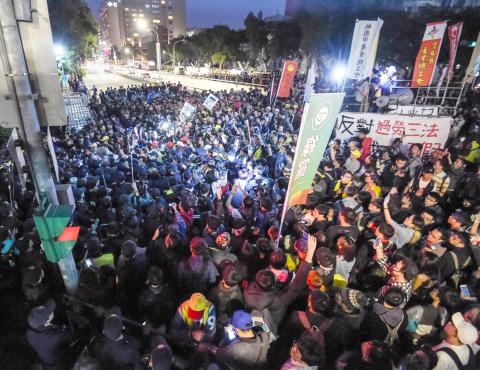
Photo: Huang Yao-cheng, Taipei Times
Several scuffles broke out between protesters and police when police tried to narrow down the demonstration area at the intersection between the Zhongshan N Road and Zhongxiao E Road.
Instead of continuing their march along Zhongxiao W Road, the organizers urged protesters to stage a sit-in at the intersection and wait for the Cabinet to respond to their appeal, but they received no response and dismissed the demonstration at 6pm.
Despite the dismissal, some protesters were still occupying the intersection as of press time last night.
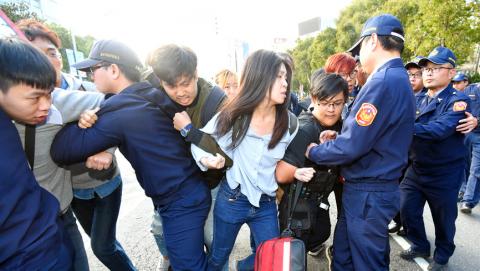
Photo: Liu Hsin-de, Taipei Times
Prior to the dismissal, some protesters tried to break through a police blockade set up in front of the Executive Yuan complex.
One member of the Social Democratic Party, surnamed Lu (呂), was forcibly removed from the scene by police, with his left ear allegedly cut on the wired barricades.
Since the Cabinet announced the draft amendment on Nov. 9, many labor rights groups have been protesting against what they said is the most retrogressive amendment to the act, which was pushed to a second reading by DPP lawmakers on Dec. 4.
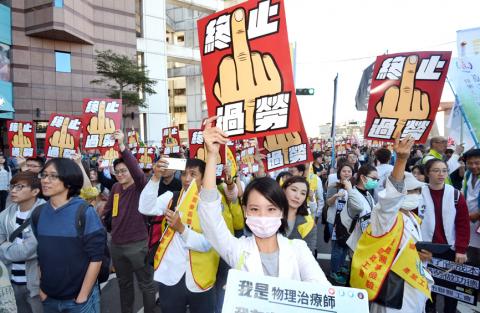
Photo: Liu Hsin-de, Taipei Times
Anticipating the demonstration yesterday, Cabinet spokesperson Hsu Kuo-yung (徐國勇) and Minister of Labor Lin Mei-chu (林美珠) tried to clarify what they called a “misunderstanding” about the draft amendment at a news conference on Thursday.
In the Cabinet’s draft, Article 34 proposes that the interval between two work shifts can be reduced from 11 hours to no less than eight hours if an employer obtains approval from its workers’ union.
Most people oppose the article because they do not understand its two premises: It only applies to those who have to work in shifts, and people are not allowed to work more than 12 consecutive hours, Hsu said.
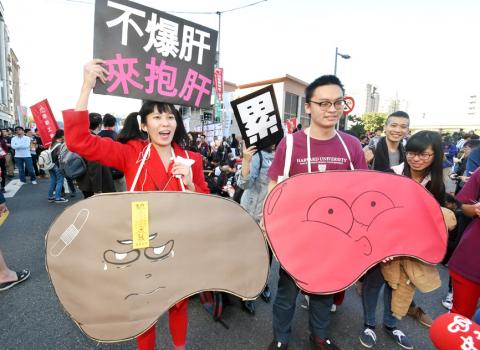
Photo: Liu Hsin-de, Taipei Times
The work schedule of employees can be changed once a week at most, but the restriction becomes irrelevant when employers and employees reach an agreement, according to the draft.
Some lawmakers have tendered motions that propose businesses should obtain the ministry’s approval before they are allowed to shorten workers’ rest intervals, Lin said, adding that the ministry thinks the proposal is feasible and would include it in the final draft.
No one misunderstood the articles, at least the Taipei City Government did not, Taipei Department of Labor Commissioner Lai Hsiang-lin (賴香伶) said yesterday when asked to comment on Hsu’s explanation.
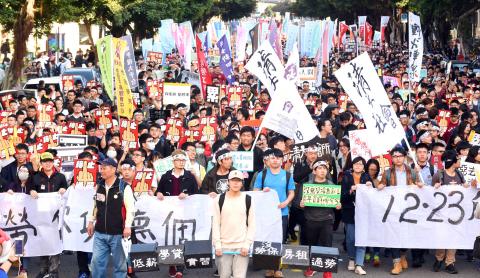
Photo: Liu Hsin-de, Taipei Times
Many hospital management teams, due to staff shortages, are likely to change workers’ schedules almost every day, which is a fact that the Cabinet fails to understand, Lai said, adding that it should encourage businesses to hire more workers instead of easing regulations.
The ministry should set up a registration system and ask businesses adopting shifts to fully reveal their schedule information, she said.
If businesses are to lengthen employees’ working hours, they should obtain approval from the ministry, which could be helpful to prevent employers from abusing the loosened regulation, she added.
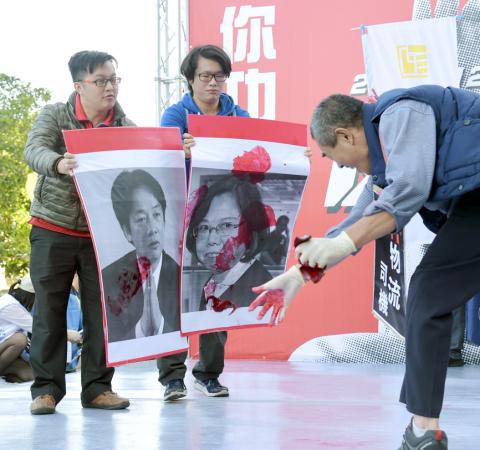
Photo: Huang Yao-cheng, Taipei Times
Employers are likely to force workers to sign agreements that say that they agree with the lengthened work schedules, Taiwan Higher Education Union department director Lin Po-yi (林柏儀) said.
People who have to work in shifts, such as guards, nurses and drivers in the logistics industry, are relatively powerless in society, Lin Po-yi said, adding that the draft amendment would worsen their already poor working conditions.
The DPP has forsaken the public, who cannot but take to the streets to defend its values, Chinese Nationalist Party (KMT) Legislator Chiang Wan-an (蔣萬安) said.
Asked if the KMT has any strategies to boycott the draft amendment in the extraordinary legislative session next month, Chiang said that party members are discussing plans, but cannot reveal them at the moment.
During a visit to Tainan yesterday, Premier William Lai (賴清德) said he would ask the Ministry of Labor to collect the appeals of protesters, but no further response could be solicited from the Cabinet as of press time last night.

The US government has signed defense cooperation agreements with Japan and the Philippines to boost the deterrence capabilities of countries in the first island chain, a report by the National Security Bureau (NSB) showed. The main countries on the first island chain include the two nations and Taiwan. The bureau is to present the report at a meeting of the legislature’s Foreign Affairs and National Defense Committee tomorrow. The US military has deployed Typhon missile systems to Japan’s Yamaguchi Prefecture and Zambales province in the Philippines during their joint military exercises. It has also installed NMESIS anti-ship systems in Japan’s Okinawa

‘WIN-WIN’: The Philippines, and central and eastern European countries are important potential drone cooperation partners, Minister of Foreign Affairs Lin Chia-lung said Minister of Foreign Affairs Lin Chia-lung (林佳龍) in an interview published yesterday confirmed that there are joint ventures between Taiwan and Poland in the drone industry. Lin made the remark in an exclusive interview with the Chinese-language Liberty Times (the Taipei Times’ sister paper). The government-backed Taiwan Excellence Drone International Business Opportunities Alliance and the Polish Chamber of Unmanned Systems on Wednesday last week signed a memorandum of understanding in Poland to develop a “non-China” supply chain for drones and work together on key technologies. Asked if Taiwan prioritized Poland among central and eastern European countries in drone collaboration, Lin
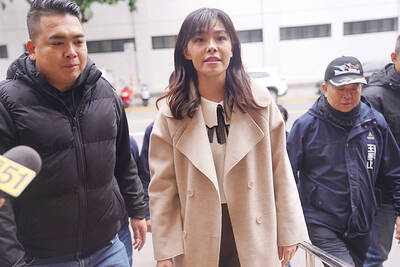
BACK TO WORK? Prosecutors said they are considering filing an appeal, while the Hsinchu City Government said it has applied for Ann Kao’s reinstatement as mayor The High Court yesterday found suspended Hsinchu mayor Ann Kao (高虹安) not guilty of embezzling assistant fees, reducing her sentence to six months in prison commutable to a fine from seven years and four months. The verdict acquitted Kao of the corruption charge, but found her guilty of causing a public official to commit document forgery. The High Prosecutors’ Office said it is reviewing the ruling and considering whether to file an appeal. The Taipei District Court in July last year sentenced Kao to seven years and four months in prison, along with a four-year deprivation of civil rights, for contravening the Anti-Corruption

NO CONFIDENCE MOTION? The premier said that being toppled by the legislature for defending the Constitution would be a democratic badge of honor for him Premier Cho Jung-tai (卓榮泰) yesterday announced that the Cabinet would not countersign the amendments to the local revenue-sharing law passed by the Legislative Yuan last month. Cho said the decision not to countersign the amendments to the Act Governing the Allocation of Government Revenues and Expenditures (財政收支劃分法) was made in accordance with the Constitution. “The decision aims to safeguard our Constitution,” he said. The Constitution stipulates the president shall, in accordance with law, promulgate laws and issue mandates with the countersignature of the head of the Executive Yuan, or with the countersignatures of both the head of the Executive Yuan and ministers or